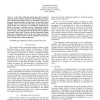Free Online Productivity Tools
i2Speak
i2Symbol
i2OCR
iTex2Img
iWeb2Print
iWeb2Shot
i2Type
iPdf2Split
iPdf2Merge
i2Bopomofo
i2Arabic
i2Style
i2Image
i2PDF
iLatex2Rtf
Sci2ools
FGR
2011
IEEE
2011
IEEE
On dimensions in emotion psychology
— Is the study of the dimensional space that is meant to represent human emotions helpful in understanding the mechanisms underlying emotional processes? Emotional experience is frequently described along a certain number of dimensions, often including valence and arousal. This paper argues that dimensional models may obfuscate the mechanisms underlying the genesis of emotions. A parallel is drawn to dimensions of gustatory experience. Data are presented on the dimensional representation of taste, and compared with information about peripheral processing of basic tastes. While the obvious discrepancies might inspire more fascinating search for the next stage of gustatory processing, too little is known on basic emotional processing, in order to profit from a similar comparison. Emotional space; dimensions; valence; arousal; sweet; sour
| Added | 28 Aug 2011 |
| Updated | 28 Aug 2011 |
| Type | Journal |
| Year | 2011 |
| Where | FGR |
| Authors | Christian Kaernbach |
Comments (0)

